2021 recorded a year-on-year drop of 16.8% against 2020, with 3,649 vehicles hitting UK roads. Double-deck buses, in particular, fell by over a third (35.4%), cementing the overall decline. With the final quarter seeing a 31.6% drop, this marks the lowest number on record of registrations since registrations began in 1996, in statistics released by the Society of Motor Manufacturers and Traders (SMMT).
Sector Looking to Bus Back Better Government Fund and Levelling up Ambitions to See Recovery of Ridership Going Forward
The last quarter saw some fairly noticeable drops, with all sectors affe...
Sector Looking to Bus Back Better Government Fund and Levelling up Ambitions to See Recovery of Ridership Going Forward
The last quarter saw some fairly noticeable drops, with all sectors affe...








